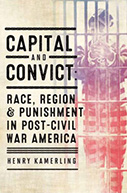Capital And Convict: Race, Region, And Punishment In Post-Civil War America

Author: Henry Kamerling
Publisher: Charlottesville and London: University of Virginia Press, 2017. 328p.
Reviewer: Vivien Miller | July 2018
By comparing the formal state penal systems of Illinois and South Carolina between 1865 and 1886, Capital and Convict sets out to challenge scholarly perceptions of mid-to-late nineteenth-century North-South penal and cultural differences, and the dominant view that southern practices were more brutal. It builds on earlier studies of Illinois prisons and prisoners by Mara Dodge and James Jacobs for example, and provides a welcome critique of South Carolina’s nineteenth-century prison history which has received less scholarly attention than Georgia and Texas for example. To highlight the role of the prison in post-Civil War state formation and the political economy, Kamerling uses three “different lenses” to structure the book and its three main sections: the race and class politics of punishment, the industrial capitalism ideology guiding incarceration policies and practices, and the lived experiences of convicts and convict culture.
In the 20 years after the Civil War, both states’ penal systems underwent considerable change – which undoubtedly contributed to the endemic violence that Kamerling describes in the section on convict culture. Convicts in both systems certainly experienced similarly exploitative prison regimes, miserable conditions, and brutal methods of discipline. Despite marked demographic and geographic differences, Illinois and South Carolina inmates also utilised escape, mutilation, and other forms of defiance and resistance that were remarkably similar.
South Carolina’s first state penitentiary was constructed at Columbia in 1867; from 1876, convict leasing became the dominant mode of incarceration, but a prison farm system was also adopted in the 1880s. Not surprisingly, labour exploitation, an ideology of white supremacy and corresponding (mis)conceptions of the supposed reform and rehabilitative deficiencies of African American convicts shaped decisions about incarceration and prison operations. Yet, Kamerling demonstrates that the political dominance of Black Radical Republicans in South Carolina, and their control of the state legislature throughout the Reconstruction period, ensured black influence over the appointments of key prison personnel (but did this include employment of black guards?), serious investigations into inmate conditions and mistreatment, and deferred the adoption of convict leasing. This study therefore offers a more nuanced account of South Carolina’s leasing history than previous works.
Meanwhile, Illinois lawmakers alternated between leasing and state’s account systems to control spiralling prison costs and to promote penal self-sufficiency. With 1,160 inmates in 1868, and that number rising throughout the late nineteenth century, Joliet became a large-scale manufacturing enterprise, but this was disrupted by a growing class-based labour union and political movement that opposed private contractors profiting from cheap convict labour. As Kamerling further demonstrates, each state’s political economy shaped lawmaker and prison official responses to the rehabilitative and restorative New Penology ideology of the 1870s and 1880s.
While Capital and Convict is an impressively researched, well-presented, and insightful study, there are two curious omissions: women convicts and prison guards. An explanation for the former is buried in a footnote, namely that Illinois’s female convicts have been admirably critiqued in Mara Dodge’s 2002 book, and studies of post-bellum southern women prisoners in Alabama and Georgia are referenced. Nevertheless, South Carolina’s women convicts seem to have been written out. The study further addresses the changing views and roles of different groups of “prison men” including prison commissioners, chaplains, and medical men. There are references to superintendents and some guards but no direct critique of the guard corps at either Joliet or Columbia. If as Kamerling argues, the “central dialectic” of the penitentiary is “the synthesis of the prison keepers’ quest for control and convicts’ resistance to the jailers” then deeper understanding of the backgrounds and working conditions and lives of the keepers who had direct, daily contact with inmates is crucial.
Vivien Miller, University of Nottingham UK


